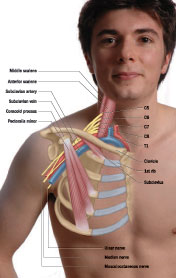Brachial Plexus
The Brachial Plexus is a nerve bundle that brings sensation to the upper extremity. It exits the spine at the neck and passes through the bones and soft tissues of the thoracic outlet to the front of the shoulder. At the front of the shoulder, the nerve bundle separates into the various nerves that bring sensation and function to the arm and hand: the median nerve, the ulnar nerve, the radial nerve, and the musculocutaneous nerve.
Things That Interfere With
The Brachial Plexus

The brachial plexus, like all nerves, is covered in a protective sheath of fascia that allows it to slide and glide through the densely packed area of the neck and shoulder. When excess tension or compression develops in this part of the body, the brachial plexus is prone to becoming bonded to neighboring structures. As they move or contract, the nerve bundle gets tugged and irritated, eventually leading to pain, numbness and dysfunction.
The most problematic sites for the brachial plexus are
- As the nerve bundle passes between the scalene muscles at the neck
- As the bundle passes between the first rib and the collarbone
- As the bundle passes under the pectorals minor muscle at the front of the shoulder
The brachial plexus can be compromised in any or all of these areas, leading to the specific symptoms that a person experiences, commonly known as Thoracic Outlet Syndrome.
Releasing The Brachial Plexus
In order to free the brachial plexus from its stuck spots, gentle and targeted stretching can help you release the nerve bundle. Because of the potentially sticky and restrictive nature of fascia that is under stress, it's possible that any muscle, bone, or neighboring blood vessel could be glued to the brachial plexus, overstimulating it and causing potential damage.
As you stretch the stuck tissue in order to release the brachial plexus, the nerve will almost always generate nerve sensations which can be very distressing. It is critically important to learn how and when to safely stretch any area affecting a nerve, when to stop, and how to recognize a safe stretch from a potentially damaging one. Releasing the brachial plexus happens in baby steps, but the cumulative effect can be a dramatic decrease in nerve-related symptoms.
Complete instructions on how to safely release the brachial plexus are included in the Thoracic Outlet Syndrome Self Care Toolkit. Click here to find out more.
Learn more by visiting the following links:
Click the block below that most closely matches your injury for more information and to find the Toolkit we offer to help you in your recovery.







